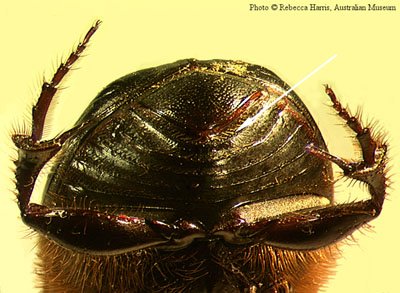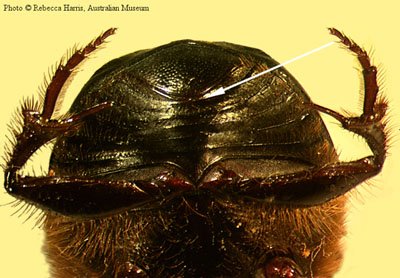![]()
![]()
![]()
 The Importance of Dung Beetles
The Importance of Dung Beetles
Dung beetles play a crucial role in natural and agricultural ecosystems. The majority are coprophagous, using the faecal material of various animals for food and to provide brood balls for the larvae, which live in chambers or burrows in the ground. Some species also feed on or prefer carrion, mushrooms, fallen fruit or decomposing plant material.
Dung beetles aerate and mix the soil by burrowing, and increase the organic matter content of the soil by burying dung. These changes improve the water holding capacity and nutrient availability of the soil, with associated benefits to plants. By burying dung, they also provide an important food source for decomposers, and reduce resources for the larvae of economic insect pests such as bushflies.
Taxonomy
The dung beetles belong to the family Scarabaeidae, subfamily Scarabaeinae. The World fauna of the subfamily Scarabaeinae includes approximately 5,000 described species in 234 genera. In Australia, the native fauna includes 20 genera and 335 described species (Cassis & Weir, 1992). 10 native genera and 84 native species are found on the east coast of NSW: Amphistomus (4 spp), Aptenocanthon (2 spp), Aulocopris (2 spp), Cephalodesmius (2 spp), Demarziella (4 spp), Diorygopyx (7 spp), Lepanus (5spp), Monoplistes (1 sp), Onthophagus
(54 spp) and Thyregis (3 spp).
This key also includes the introduced dung beetles found on the east coast of NSW. These belong to the genera Euoniticellus (2 spp), Liatongus (1 sp), Onitis (4 spp), Onthophagus (4 spp) and Sisyphus (1 sp). The majority of these species originated in tropical southern Africa and southern Europe, and were introduced as part of the CSIRO Dung Beetle Program. This project aimed to establish a dung beetle fauna in Australian pastures, which, by rapidly burying the dung of domestic stock, would benefit pasture production and reduce the number of pest flies (Doube et al. 1991, Tyndale-Biscoe 1990).
The characters used for sexing dung beetles vary to a certain extent between genera, but in general males can be distinguished from females by comparing the last abdominal sternite. In male dung beetles this sternite is medially shortened, while in females it is of equal length throughout.
Collecting Dung Beetles
Baited pitfall traps are the main method for collecting dung beetles. Pitfall traps are made up of a container (glass, plastic, waxed paper etc.) sunk into the ground so that the rim is flush with the surface. The bait is wrapped in cloth and tied or suspended from the end of a stick over the centre of the trap. The trap should have fluid in it to dissuade predatory animals from eating the contents. At minimum, water with some soap and salt will drown the insects and preserve them for a day or so. Baits commonly used include mammal entrails from road kills, human excrement and cow dung.
This method will attract most species of dung beetle. However, some species are not attracted to dung baits, so a variety of baits should be used, including rotting mushrooms, fruit and carrion. Many species fly and are attracted to light at night.
Dung beetles generally occur in the greatest numbers and diversity in summer and are most active after rain. Most indigenous species are found in woodland or forest, while the introduced species are restricted to open woodland and pastures.
Several specimens of each species should be preserved to increase the chances of collecting the males, which are generally much easier to identify than females.


